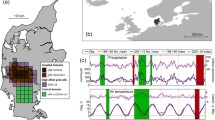Abstract.
The performance of the Canadian Land Surface Scheme (CLASS) when coupled to the CCCma third generation general circulation model is evaluated in an AMIP II simulation. Our primary aim is to understand how CLASS processes moisture and to compare model estimates of moisture budget components with observations. The modelled mean annual precipitation and runoff, and their latitudinal structures, compare well with observations although some discrepancies remain in the simulation of regional values of these quantities. The amplitude and phase of the first harmonic of the precipitation annual cycle also compares well with observations although less well over regions of sparse precipitation and/or high topography. In the model, the canopy plays a major role in processing moisture at the land surface indicating the importance of vegetation in climate. The canopy intercepts a large fraction of the precipitation and provides the medium for returning much moisture back to the atmosphere as evapotranspiration. Though important locally, the snow moisture reservoir plays a relatively minor role in the global moisture budget. It acts primarily as a storage and delay mechanism with winter precipitation released to the ground reservoir on melting. The ground moisture reservoir also plays a major role and processes a similar amount of moisture as the canopy, although in a different manner. The globally averaged model runoff compares well with observation-based estimates, although the model partitioning into surface runoff and drainage does not agree particularly well with the single available observation-based estimate. How moisture is processed at the land surface serves as a basis for model intercomparison and for understanding the modelled moisture budget and its variation and changes with climate change. Only the most basic quantities (precipitation, runoff, and partitioning of runoff into surface runoff and drainage) may be compared with observation-based estimates, however, and the establishment of more complete moisture budget remains an important need.
Similar content being viewed by others
Author information
Authors and Affiliations
Additional information
Electronic Publication
Rights and permissions
About this article
Cite this article
Arora, .V., Boer, .G. A GCM-based assessment of the global moisture budget and the role of land-surface moisture reservoirs in processing precipitation. Climate Dynamics 20, 13–29 (2002). https://doi.org/10.1007/s00382-002-0274-4
Received:
Accepted:
Issue Date:
DOI: https://doi.org/10.1007/s00382-002-0274-4




